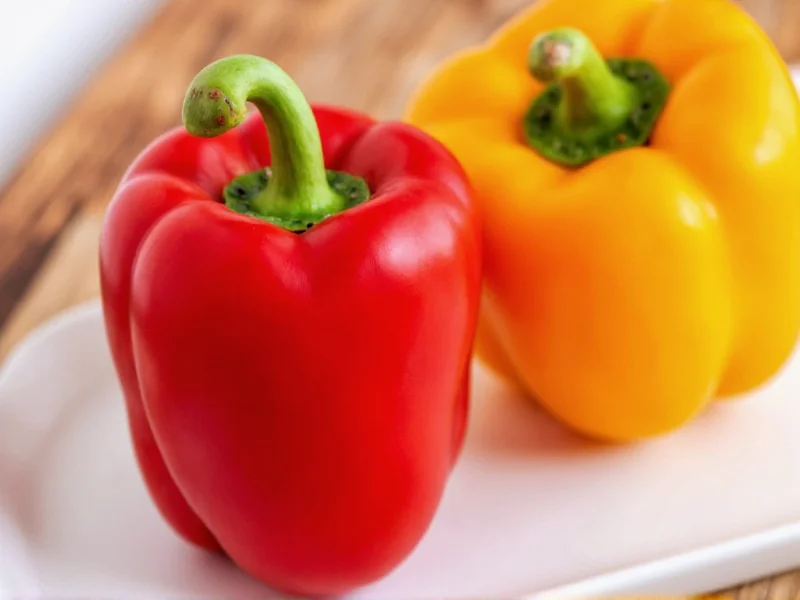The Science Behind Bell Pepper Sweetness
Bell peppers undergo significant biochemical changes during ripening. The key factor in sweetness development is the conversion of starches to sugars, primarily glucose and fructose. Green bell peppers contain higher levels of chlorophyll and lower sugar content. As they mature:
- Chlorophyll breaks down, revealing underlying pigments
- Starches convert to simple sugars through enzymatic activity
- Vitamin C content increases by up to 50% compared to green stage
- Antioxidant levels rise significantly, particularly carotenoids
This maturation process explains why red bell peppers consistently test higher on the Brix scale (a measurement of sugar content in produce) than their less ripe counterparts. On average, red bell peppers contain approximately 6-9% sugar by weight, while green varieties contain only 3-5%.
Bell Pepper Color Spectrum and Sweetness Levels
| Color | Ripeness Stage | Sweetness Level | Time to Maturity |
|---|---|---|---|
| Green | Least ripe | Mildly bitter, vegetal | 60-75 days |
| Yellow | Partially ripe | Moderately sweet | 75-85 days |
| Orange | Mostly ripe | Sweet | 80-90 days |
| Red | Most ripe | Most sweet | 85-95 days |
| Purple | Varietal difference | Mildly sweet | Varies |
The progression from green to red represents the complete ripening cycle for standard bell pepper varieties. Some specialty cultivars may follow different color paths (like green to chocolate brown), but the principle remains consistent: extended time on the plant equals increased sweetness.
Nutritional Differences Across the Color Spectrum
As bell peppers ripen and change color, their nutritional profile evolves significantly. The sweetest red bell peppers offer notable advantages:
- Contain nearly 11 times more beta-carotene than green peppers
- Have up to 1.5 times more vitamin C than green varieties
- Develop higher concentrations of lycopene, a powerful antioxidant
- Feature increased levels of other carotenoids like lutein
These nutritional enhancements accompany the flavor transformation, making fully ripe red bell peppers not only the sweetest but also the most nutrient-dense option among common bell pepper colors.
Selecting the Sweetest Bell Peppers
When shopping for the sweetest bell peppers, look for these characteristics:
- Bright, uniform color without green streaks (for red peppers)
- Firm, thick walls that feel heavy for their size
- Smooth, glossy skin without wrinkles or soft spots
- A fresh, green stem that appears recently cut
Seasonality affects sweetness too. Bell peppers reach peak sweetness during summer and early fall when they've had optimal growing conditions. Off-season peppers may lack the full sweetness potential of peak-season varieties.
Culinary Applications of Sweet Bell Peppers
The pronounced sweetness of red bell peppers makes them ideal for various culinary applications where you want to enhance natural sugars:
- Eating raw in salads where their sweetness shines without cooking
- Roasting to concentrate natural sugars through caramelization
- Adding to sauces and salsas for natural sweetness without added sugar
- Pairing with bitter greens to balance flavor profiles
- Using in desserts or sweet applications where vegetable sweetness is desired
Chefs often select red bell peppers specifically when a recipe calls for sweet pepper flavor without the sharpness of less ripe varieties. Their natural sugar content makes them particularly suitable for dishes where you want to minimize added sugars.
Common Misconceptions About Bell Pepper Sweetness
Several myths persist about bell pepper sweetness that deserve clarification:
- Myth: Different colored bell peppers come from different plant varieties
Fact: Most color variations come from the same plant at different ripeness stages - Myth: Orange bell peppers are sweeter than red
Fact: Red peppers continue ripening beyond the orange stage, developing more sugars - Myth: All red bell peppers are equally sweet
Fact: Sweetness varies by cultivar, growing conditions, and exact harvest time
Understanding these distinctions helps consumers make informed choices when selecting bell peppers for specific culinary purposes where sweetness matters.











 浙公网安备
33010002000092号
浙公网安备
33010002000092号 浙B2-20120091-4
浙B2-20120091-4